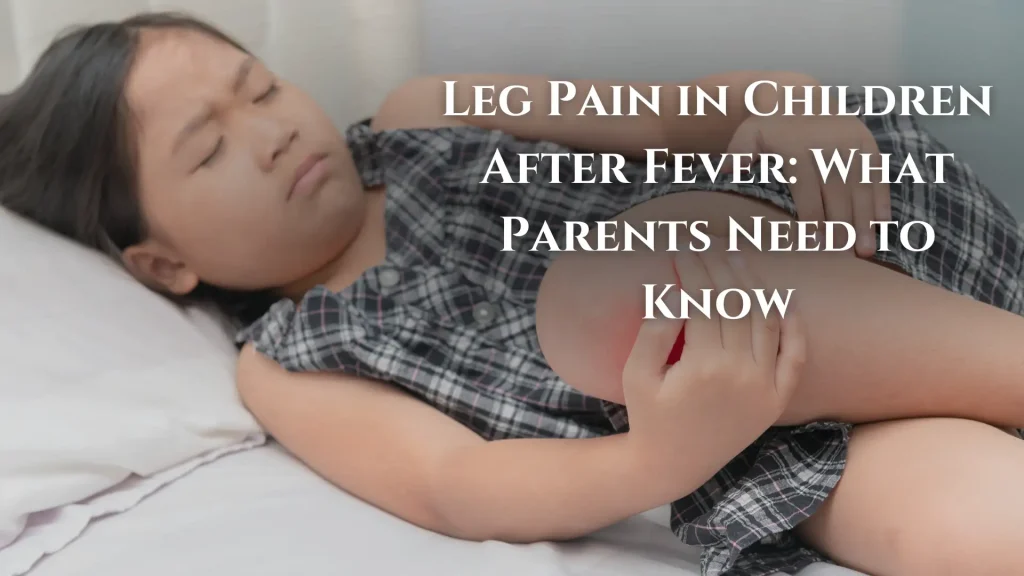
When a child recovers from a fever, they should start feeling better quickly. But if they begin complaining about leg pain, it can be confusing and concerning for parents. Muscle aches after an illness are often part of the body’s natural healing process.
However, leg pain can sometimes signal a more serious issue that needs medical attention. In such cases, timely leg pain treatment is essential to address the underlying cause and prevent further complications.
Understanding the possible causes can help you decide whether it’s a usual post-viral symptom or a reason to contact a doctor. If you’re wondering what causes joint and muscle pain in children, the factors can range from minor infections to more serious inflammatory conditions.
Common Causes of Leg Pain After Fever in Children
Several conditions can lead to leg muscle pain following a fever. While most are temporary and not cause for concern, some require medical attention due to these types of pain.
- Post-viral myositis—A common cause of leg pain after a viral infection in a child, occurs when a virus causes temporary muscle inflammation. It usually affects the calves and can make walking uncomfortable.
- Viral arthritis – Some infections cause joint inflammation, leading to fever and joint pain in children. The knees, ankles, and hips are most commonly affected.
- Growing pains vs. post-viral leg pain – While growing pains usually happen at night and are not linked to illness, post-viral muscle aches in school-age children can occur anytime after a fever.
- Rheumatic fever and leg pain – Though rare in the U.S., untreated strep throat can lead to rheumatic fever, which causes inflammation in the joints and can result in long-term complications.
- Other infections—Bacterial infections like osteomyelitis (bone infection) or septic arthritis (joint infection) can cause severe leg pain and swelling and require urgent medical care.
Recognizing the cause of your child’s leg pain after a fever can help you determine whether it is a passing discomfort or something that needs medical attention. In some cases, physical therapy for pain may be recommended to support recovery and restore mobility.
When to Seek Medical Attention
Leg pain after a fever isn’t a big deal and goes away as the body heals. But in some cases, specific symptoms could mean there’s something more serious going on. Paying attention is essential if the pain doesn’t seem to improve or comes with other unusual signs and symptoms.
. You should think about calling your child’s doctor if they have:
- Persistent joint pain lasting more than a few days
- Swelling, redness, or warmth in the legs
- Difficulty walking or refusal to bear weight
- A high fever that returns after initially going away
- Severe pain that worsens instead of improving
These symptoms may indicate an infection or a serious condition requiring quick medical attention. If you notice them, seek professional guidance to determine if the pain is normal or needs treatment.
Please read more about pain treatment here: What are the best treatments for joint pain?
When should I go to the ER for leg pain?
 Emergency care may be necessary if your child experiences any of the following symptoms:
Emergency care may be necessary if your child experiences any of the following symptoms:
- Sudden, severe leg pain that worsens quickly
- Loss of sensation, numbness, or weakness in the legs
- Difficulty moving their legs or an inability to walk
- Signs of a severe infection, such as a high fever, chills, or worsening redness and swelling
These symptoms could indicate a more serious underlying condition, such as a neurological issue, a deep infection, or a circulatory problem. If you are unsure whether your child needs immediate care, contact AllCare Health & Pain for professional guidance. Our team specializes in pediatric pain management and can help you determine the appropriate next steps. 201-386-9800
How to Treat Leg Pain and Fever in a Child at Home
If your child’s leg pain is not severe, at-home remedies can help relieve discomfort while they recover:
- Rest and hydration – Encourage your child to take it easy and drink plenty of fluids to support their immune system.
- Warm baths – A warm bath can soothe sore muscles and promote relaxation.
- Gentle stretching and massage – Lightly massaging the legs can ease muscle tension and improve circulation.
- Over-the-counter pain relievers – If your child is uncomfortable, acetaminophen or ibuprofen (as directed by their doctor) can help reduce pain and inflammation.
Check out our pediatric pain management services for more advice on managing post-illness discomfort.
Is Leg Pain After a Fever Normal?
Leg pain after a fever is usually just a short-term reaction to a virus and goes away in a few days. But it’s still important to pay attention if the pain doesn’t improve or comes with other symptoms like swelling or trouble walking. If things seem to be worsening instead of improving, it’s a good idea to talk to a doctor.
Our expert team is here to help you manage chronic pain and improve your mobility for a healthier, active life. If you’re concerned about your child’s symptoms, don’t wait to get help—contact AllCare Health & Pain to schedule an evaluation and get tailored leg pain treatment in New Jersey. Visit our contact page or call 201-386-9800 for immediate assistance.

